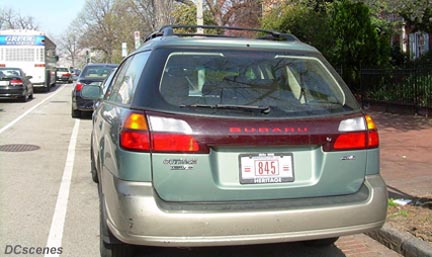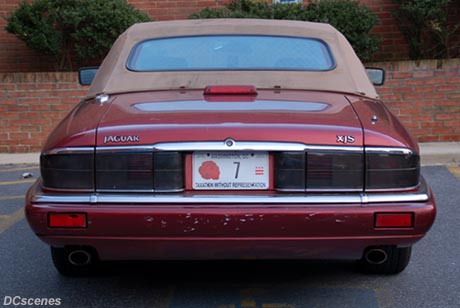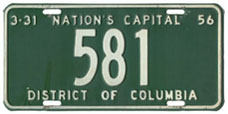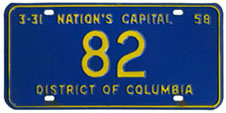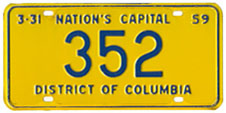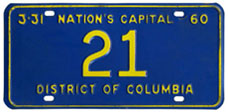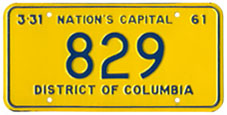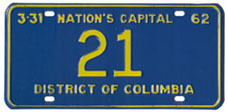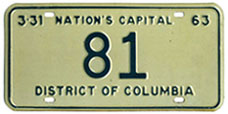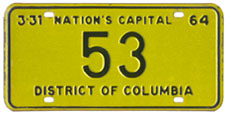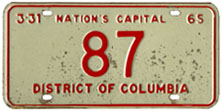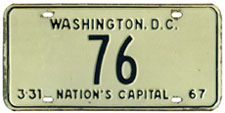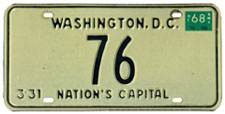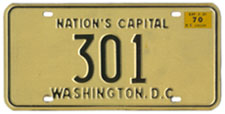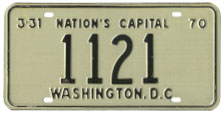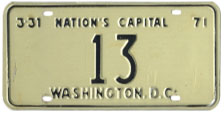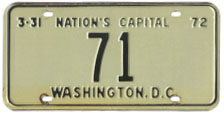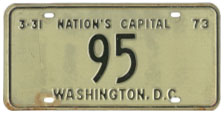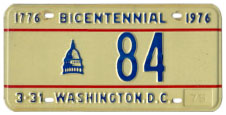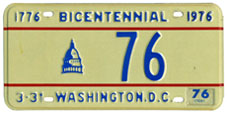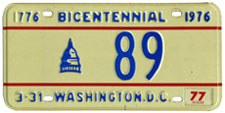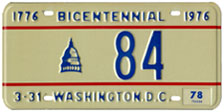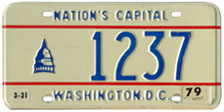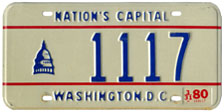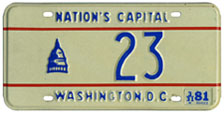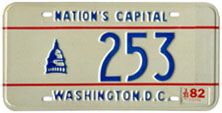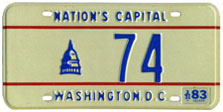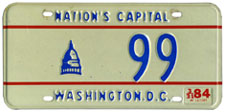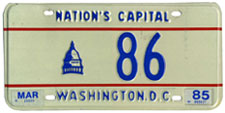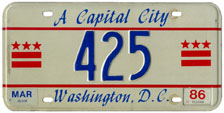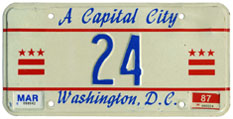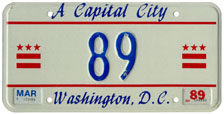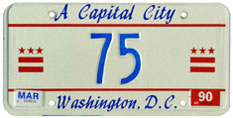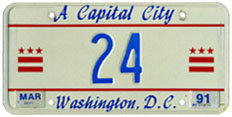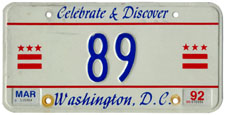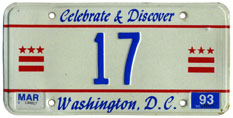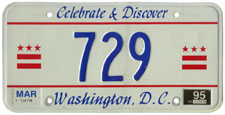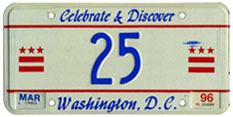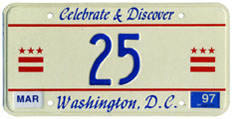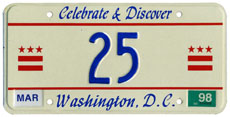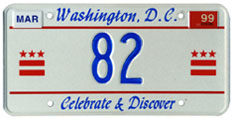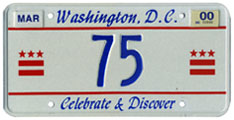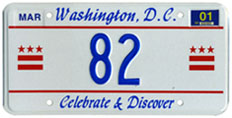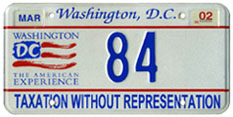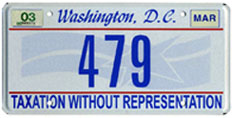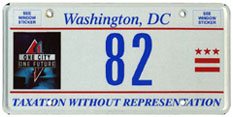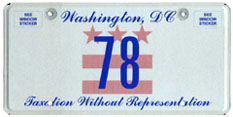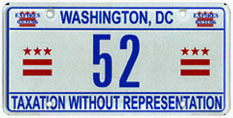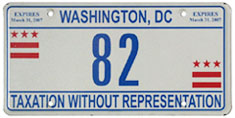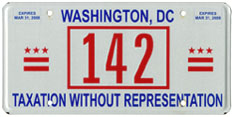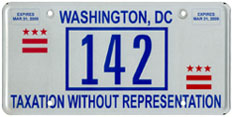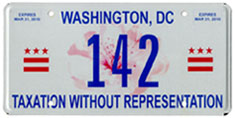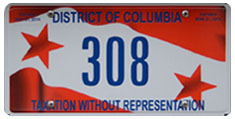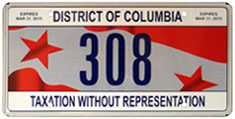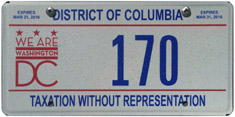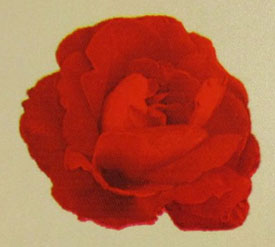District of Columbia Reserved-Number License Plates
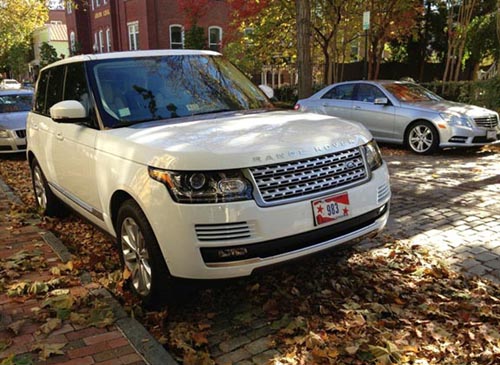 |
||
Few D.C. license plates are as distinctive as the 2013-14 reserved-number issue. This autumn scene in the heart of Georgetown shows a Range Rover with plate no. 983 parked on P St., NW across from Hyde-Addison Elementary School. Although the cable car tracks embedded in O and P Streets have not been used since 1960 they are carefully preserved to maintain the character of this historic neighborhood. |
DCplates.net has created this page to address reserved-number plates because, especially since 2001, they have been distinctive in their appearance (see below) compared to other Washington, D.C. plates. Determining which 1918-1926 registration numbers could be considered reserved (i.e. those reserved for certain registrants year after year) by modern standards is difficult because all auto plates throughout this period were numbered beginning at 1 and proceeding as high as necessary. For 1927, however, the general-issue configuration was changed to include a letter prefix, making all-number plates more distinctive. Here is a summary of numbers considered reserved, and discussed below, since 1927 along with the general-issue format(s) used during each period:
Reserved Numbers |
General-Issue Formats |
||
| 1927-1929 | 1 through 1000 |
A-1, A-12, A-123, A-1234 | |
| 1930-1954 | 1 through 9999 |
A-1, A-12, A-123, A-1234; 12-345, 123-456; 1-2345 | |
| 1955, 1956 | 1 through 1000 |
AB-12-34 | |
| 1957-1959 | 1 through 1200 |
AB-123 | |
| Since 1960 | 1 through 1250 |
AB-123; 1A234; 1AB23; 123-456; AB-1234 |
In addition to being included in our discussion below, general-issue registration numbers are addressed elsewhere in various contexts on other pages of this site. For example, topics such as which numbers were assigned annually from 1907 through 1917 and the various general-issue formats of the 1960s are addressed on pages dedicated to those periods. Click here to reach the top of our non-passenger plates page for links to other places on the site where registration numbers are addressed.
 |
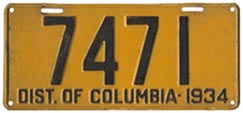 |
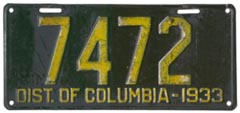 |
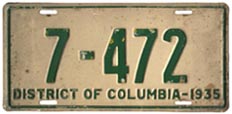 |
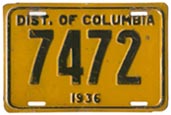 |
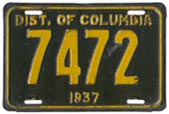 |
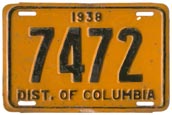 |
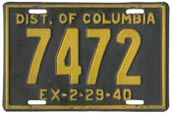 |
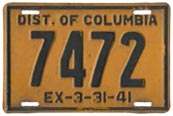 |
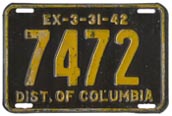 |
1939 |
1940 |
1941 |
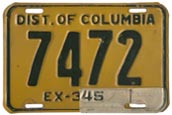 |
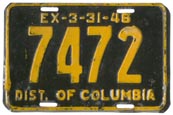 |
 |
1942-44 |
1945 |
1946-47 |
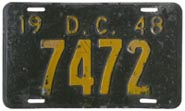 |
||
1948 |
||
After 1926, auto plates with high four-digit numbers such as 7471 and 7472 were issued only from 1930-1954. Represented in this well-preserved collection are 16 of those years. Each of the plates shown is the better example of a pair that has remained together for more than 60 years, with the sole exception of 1945 because only a single plate was made for each vehicle that year in conjunction with the conservation of metal for non-military uses during World War II. |
||
Registration Number Assignment from 1907 through 1934:
Most Numbers Randomly Assigned
The first city-issued plates were introduced in 1907. From then until 1917 (the "porcelain era") the same series of numbers was used. Registration numbers were assigned beginning with 1 in 1907 and progressed, on the same type of undated plate, through the end of 1917 when numbers are estimated to have reached approximately 67100.
There have historically been questions as to the starting point of D.C. plate numbers during the porcelain era (as well as later). Our best evidence of numbers having been issued starting at 1 in 1907 is a registration listing book published in 1912 in which the names of vehicle owners and businesses to whom plates numbered 1 through 11060 had been assigned. Most registrations through number 83 were issued to dealers for use on "demonstrating cars," and the first ten numbers were assigned to the Pope Automobile Company. Some numbers below 83 in the 1912 list have no registrant data associated with them presumably because the registrations were cancelled. Numbers were not reassigned during the porcelain era, but rather were simply abandoned. Three- and four-digit numbers were also assigned to vehicle dealers as the need arose throughout this era, and numbers 2501 through 3100 were set aside for assignment "to Motor Cycle owners only." Blocks of higher numbers were also set aside for use exclusively on motorcycle plates, but exactly how many of these blocks existed and at what numbers they began and ended is unknown. (Read more about this here.)
Because every number was issued only once between October 1907 and the end of 1917 there were likely none that were considered "reserved." That's not to say, however, that certain numbers were not considered desirable and were not therefore spoken for long before they came along in the sequence of assignment. As happened in other jurisdictions in later years, and even as the first registrations were issued, in the District of Columbia special numbers such as 50000, 55555, and 56789 were probably requested in advance of when they would have otherwise been issued.

1918-1926: All-Numeric Auto Registrations
The numbering format utilized from 1918 through 1926 does not necessarily lend itself to a group of numbers easily being identified as "low" because all registrations were comprised only of numbers. However, even if it was not easy (or in fact necessary) to differentiate between a "low" and "regular" number as plate collectors are inclined to do today, it appears that some numbers were already being reserved.
 Our best evidence of this is a set of 13 plates, one from each year from 1923 through 1935, all with the number 29. As discussed below we believe that a more formal system of reserving numbers year after year for certain vehicle owners was likely not put in place until 1935, yet this group of no. 29 plates is essentially direct evidence that at least by the 1924 renewal season, if not earlier (possibly back to the 1919 renewal season towards the end of 1918), certain numbers were issued to the same individual or business year after year.
Our best evidence of this is a set of 13 plates, one from each year from 1923 through 1935, all with the number 29. As discussed below we believe that a more formal system of reserving numbers year after year for certain vehicle owners was likely not put in place until 1935, yet this group of no. 29 plates is essentially direct evidence that at least by the 1924 renewal season, if not earlier (possibly back to the 1919 renewal season towards the end of 1918), certain numbers were issued to the same individual or business year after year.
Existence of the no. 29 plates also suggests that D.C. registration numbers began at 1 (not 100 as previously thought) annually from at least as early as 1923, and probably back to 1918. From 1918 through 1926 numbers for all motorists were assigned sequentially as high as necessary, reaching just over the 100-000 mark in 1923 before the general-issue format was changed for 1927 to include a letter prefix, at which time plates with only numbers became more distinctive.
It is believed to have been in 1920, and possibly earlier, that plate numbers 100 through 105 (or at least 100 and 101, with the higher four numbers perhaps obtained slightly later) were first assigned exclusively to the White House. They were displayed with Maryland plates numbered 100-000 through 100-005 until 1924, when a vehicle registration reciprocity agreement with Maryland was reached, obviating the need for plates of that state on D.C.-based vehicles. Prior to 1918 numbers assigned to the White House are known to have included 4505, 16405, 16471, 16472, 20574, and 22650. More information on this interesting subject will be added to this page or a separate one in the future.
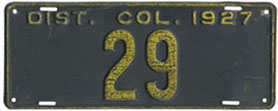 At least some numbers perceived as low today, and probably also in the 1920s, were during this era set aside for particular groups of vehicle owners as opposed to being distributed randomly to rank-and-file D.C. residents. A December 1921 Washington Post article about the distribution of 1922 plates indicates that "Tags numbered from 200 to 500 have been reserved for the motor corps of the Home Defense league." On the day that 1922 plates first became available (the final day of November 1921), several three-digit plates were issued to foreign diplomats and embassies, such as 190 to 197 to the Russian embassy and 750 to the foreign minister of Ecuador.
At least some numbers perceived as low today, and probably also in the 1920s, were during this era set aside for particular groups of vehicle owners as opposed to being distributed randomly to rank-and-file D.C. residents. A December 1921 Washington Post article about the distribution of 1922 plates indicates that "Tags numbered from 200 to 500 have been reserved for the motor corps of the Home Defense league." On the day that 1922 plates first became available (the final day of November 1921), several three-digit plates were issued to foreign diplomats and embassies, such as 190 to 197 to the Russian embassy and 750 to the foreign minister of Ecuador.
1927-1934: Annually "A Splendid Scramble" for Preferred Plate Numbers
For 1927, instead of issuing general-issue auto plates numbered above 1000, letter prefixes were introduced after that number was assigned. Specifically, the highest all-number passenger registration assigned for 1927, 1928, and 1929 was 1000, and for 1930 through 1934 it was 9999. In other words, during the late 1920s it was apparently determined that the availability of only 1,000 all-number plates wasn't enough for status-seeking Washingtonians, so the field was increased to 9,999 numbers for remaining years during which most auto plates included a letter prefix.
Although most of the all-number combinations assigned from 1930 through 1934 (that is to say, the higher four-digit numbers) probably were not reserved for particular registrants, it was during this eight-year period that D.C. motorists probably began to distinguish between auto plates with various numbering formats, especially those with numbers below 1000. An Associated Press article of early 1929, published not long after the prized 1,000 all-number plates available for that year were assigned, gives us a sense of the cache they fostered in Washington. "The social and official character of this city is revealed in the allocation of automobile tags, to a greater extent perhaps than in any other city of the country. The first thousand numbers are for privileged personages. If you are without this limit, socially and officially you are a mere nobody." In early 1931 the Ogden (Utah) Standard-Examiner characterized Washingtonian's affinity for preferred registration numbers this way: "It is not commonly known that there is a sort of social precedence in license plate numbers on motor cars in Washington, as well as in places at dinner tables in Washington, but such is certainly the case. Annually at the beginning of each license plate year in Washington there is a splendid scramble for good plate numbers. A good number...is one that doesn't have any letter of the alphabet in it."
 Articles referenced in the previous paragraph contain interesting information about the assignment of the lowest D.C. plates during this era. It confirms, for example, that the three D.C. commissioners were still receiving plates 1, 2, and 3 in (at least) 1929 and 1930, as we know they had in 1922. Other numbers below 100 were assigned to various D.C. government officials and VIPs, and number 50 was historically assigned to the chief justice of the supreme court, with numbers 51 and higher provided to the court's remaining justices in order of their seniority. By 1929, no. 50 had been assigned to Chief Justice (and former president) William Howard Taft "for many years," whereas Justice James Clark McReynolds used no. 62. Number 82 was assigned to House Speaker Nicholas Longworth. We must assume that all of the one- and two-digit numbers were used by individuals of high political and social status, for not until we reach number 100 on the roster do we find vehicles assigned to The White House. The presidential fleet in 1929 was registered with numbers 100 to 110, and number 111 was assigned to the vice president. Beginning with 112, higher numbers were assigned, at least in 1930 (and presumably other years of this era), to members of the cabinet based upon the longevity of their agency's existence. The Department of State was the oldest agency, so the secretary of state had the privilege of using registration number 112 "and whatever number[s] ensuing may be thought needed for state department cars," according to the aforementioned Ogden Standard-Examiner article.
Articles referenced in the previous paragraph contain interesting information about the assignment of the lowest D.C. plates during this era. It confirms, for example, that the three D.C. commissioners were still receiving plates 1, 2, and 3 in (at least) 1929 and 1930, as we know they had in 1922. Other numbers below 100 were assigned to various D.C. government officials and VIPs, and number 50 was historically assigned to the chief justice of the supreme court, with numbers 51 and higher provided to the court's remaining justices in order of their seniority. By 1929, no. 50 had been assigned to Chief Justice (and former president) William Howard Taft "for many years," whereas Justice James Clark McReynolds used no. 62. Number 82 was assigned to House Speaker Nicholas Longworth. We must assume that all of the one- and two-digit numbers were used by individuals of high political and social status, for not until we reach number 100 on the roster do we find vehicles assigned to The White House. The presidential fleet in 1929 was registered with numbers 100 to 110, and number 111 was assigned to the vice president. Beginning with 112, higher numbers were assigned, at least in 1930 (and presumably other years of this era), to members of the cabinet based upon the longevity of their agency's existence. The Department of State was the oldest agency, so the secretary of state had the privilege of using registration number 112 "and whatever number[s] ensuing may be thought needed for state department cars," according to the aforementioned Ogden Standard-Examiner article.
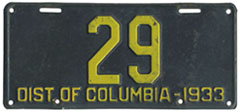 "Then will come, in due official turn, the needs of the secretary of the treasury, whose department is historically and socially the second of the government departments and inferior to the state department only," continues the Standard Examiner, adding that in 1929 numbers 114, 115, and 116 were used by the Treasury Department. "After the secretary of the treasury, in strict order of historical establishment, come the claims of the other departments and their needs. This order is war, justice, post office, navy, interior, agriculture, commerce, and labor. It is wholly impossible for a secretary of labor to get an automobile license plate number lower than the number of the secretary of commerce. The commerce department was established before the labor department and hence its license plate numbers come before the numbers of the labor department, and are lower and smaller." "When the heads of the various departments have been satisfied and scientifically located in their proper number positions, the under secretaries and the assistant secretaries and the solicitor-general of the department of justice have to be put in their appropriate license plate ranking." The solicitor general was reportedly "demoted" from number 137 to 140 in the late 1920s in a reshuffling of numbers in order to adhere to protocol, indicating that all of the cabinet members and their immediate subordinates apparently utilized no more than 30 registrations.
"Then will come, in due official turn, the needs of the secretary of the treasury, whose department is historically and socially the second of the government departments and inferior to the state department only," continues the Standard Examiner, adding that in 1929 numbers 114, 115, and 116 were used by the Treasury Department. "After the secretary of the treasury, in strict order of historical establishment, come the claims of the other departments and their needs. This order is war, justice, post office, navy, interior, agriculture, commerce, and labor. It is wholly impossible for a secretary of labor to get an automobile license plate number lower than the number of the secretary of commerce. The commerce department was established before the labor department and hence its license plate numbers come before the numbers of the labor department, and are lower and smaller." "When the heads of the various departments have been satisfied and scientifically located in their proper number positions, the under secretaries and the assistant secretaries and the solicitor-general of the department of justice have to be put in their appropriate license plate ranking." The solicitor general was reportedly "demoted" from number 137 to 140 in the late 1920s in a reshuffling of numbers in order to adhere to protocol, indicating that all of the cabinet members and their immediate subordinates apparently utilized no more than 30 registrations.
Selected members of the diplomatic corps also received some of the preferred 1,000 registrations. "The other numbers up to 1000 are held by senators, representatives, subordinate government officials, ex-government officials of all varieties, presumably distinguished private citizens, and anyone else who has enough pull to get one," reported the Associated Press in 1929. A 1934 Oakland (Cal.) Tribune article indicates that "The diplomatic corps has from 200 to 425, and its ranking is determined by due precedence. The dean of the corps, Ahmet Muhtar, ambassador from Turkey, has 200."
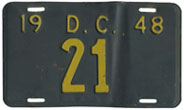
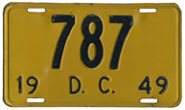
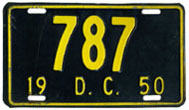
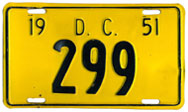
Registration Number Assignment from 1935 through 1954:
A Formal System for Reserved Numbers
It was for 1935 that the formal practice of reserving certain registration numbers for certain motorists, year after year, is believed to have begun. A related and noteworthy change that took effect in this year is the abandonment of letter prefixes on private auto (and non-passenger) plates in favor of a return to all-number plates.
From 1935 through the 1946 base (marked "3-31-47" and used, revalidated with a tab marked "48", through March 1948), passenger registration numbers began at 1 and proceeded sequentially through 9999, these numbers being considered reserved, and then picked up again at some undetermined number substantially higher than 10-000, constituting the general-issue passenger series. Numbers 10-000 through an undetermined five-digit number were used for non-passenger registrations (as discussed in our section devoted to 1937-47 registration numbers). On the 1948 through 1953 (marked "3-31-54" and used, revalidated with a tab marked "55", through March 1955) plates, reserved numbers continued to be 1 through 9999, and general-issue registrations were numbered 1-0000 through 9-9999. Plates with letter prefixes (in a series of A-1 through Z-9999) were assigned after plate 9-9999 was reached.
Various news reports of this era indicate that registrations 1 through 1000 were assigned by members of the Board of Commissioners, whereas the assignment of higher numbers through 9999 was managed by the Dept. of Motor Vehicles and Traffic. The DMV routinely lamented the resources required annually to manage the four-digit series, but despite appealing to the Commissioners for relief, none was forthcoming until 1955.
A 1947 Washington Post article indicates that during the mid-1940s, the administration of registration numbers, and in particular those considered reserved, was the responsibility of Miss. Anna C. Buettner, Registrar of the Titles and Tag Division of the DMV. “If it makes not a whit of difference to you what number your tag displays, you probably wait until the deadline to get your license. If, for sentimental or other reasons, you want a certain number among the first 1,000 tags issued, you contact Miss Buettner as early as October.” “Distribution of the first 1,000 tag numbers is such an important matter that every year Miss Buettner and the District Commissioners sit down at the conference table to parcel them out. Tradition governs issuance of certain numbers, but after that letters of request are handled in the order in which they're received. Numbers 1, 2, and 3 always go to the Commissioners, with Commissioner John Russell the recipient of 1. The numbers 100 to 110 have always been carried by White House cars, with the exception of the war years when, for safety reasons, the cars carried tags from different states. In 1948 White House cars will get back their old numbers.”
A January 24, 1952, Post article about preparations being made for the assignment of low numbers for the upcoming 1953 registration year provides additional insight about how the first 1,000 numbers were assigned. “The District Commissioners discussed the delicate question of who should get low auto tags for three hours yesterday and only half-finished the job. Some of the favored 1,000 car owners are going to lose their low tags, Commissioner F. Joseph Donohue said after the closed meeting. 'I suppose some of them will resent it,' he added, 'but if there is any advantage of having a low tag I think they should go first to the people who are giving free service to the city.' The first 1,000 tags are handed out by the Commissioners themselves. Last month the board, with two new members added in the last year, decided to review the list and weed out 'dead wood.' The city heads agreed that John Russell Young, president of the board, should have 400 to hand out. Donohue and Brig. Gen. Bernard L. Robinson were to get 300 each.”
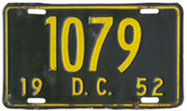 In a May 1952 memo to DMV director George E. Keneipp entitled “Time required in connection with the issuance of special or low number auto tags,” Herman S. Cole, a DMV administrative officer, wrote at length about the laborious process of managing more than 10,000 reserved plates, specifically those assigned by the DMV: 8,999 all-number combinations (numbers 1001 through 9999), as well as plates with a letter prefix followed by one or two numbers. “The detail of stamping up of some 10,000 or more applications with numbers not in sequence, stamping up these same applications with a notice that tags must be picked up by such-and-such a date, stamping a "B" on every special envelope, arranging the previous year's numerical file into title number order, matching names with tag numbers, phone calls, and personal visits and complaints, require a minimum of 700 additional hours over and above that required for the actual sale of these tags. Thus, we have a total of 1,955 hours as a most conservative figure for the hours spent on special tags. Ten thousand tags, if issued in the usual manner, would require not more than 240 man hours.” “I am firmly convinced that if there were no special numbers other than the first 1,000 assigned by the Commissioners, that our entire operation would show a marked improvement. It must be remembered that every employee of the department is beset with requests and pleas from friends, police officers and others, for special tags. The time wasted, or rather required for this, runs into countless man hours, all of which could be put to constructive use if there were no special tags.”
In a May 1952 memo to DMV director George E. Keneipp entitled “Time required in connection with the issuance of special or low number auto tags,” Herman S. Cole, a DMV administrative officer, wrote at length about the laborious process of managing more than 10,000 reserved plates, specifically those assigned by the DMV: 8,999 all-number combinations (numbers 1001 through 9999), as well as plates with a letter prefix followed by one or two numbers. “The detail of stamping up of some 10,000 or more applications with numbers not in sequence, stamping up these same applications with a notice that tags must be picked up by such-and-such a date, stamping a "B" on every special envelope, arranging the previous year's numerical file into title number order, matching names with tag numbers, phone calls, and personal visits and complaints, require a minimum of 700 additional hours over and above that required for the actual sale of these tags. Thus, we have a total of 1,955 hours as a most conservative figure for the hours spent on special tags. Ten thousand tags, if issued in the usual manner, would require not more than 240 man hours.” “I am firmly convinced that if there were no special numbers other than the first 1,000 assigned by the Commissioners, that our entire operation would show a marked improvement. It must be remembered that every employee of the department is beset with requests and pleas from friends, police officers and others, for special tags. The time wasted, or rather required for this, runs into countless man hours, all of which could be put to constructive use if there were no special tags.”
 |
 |
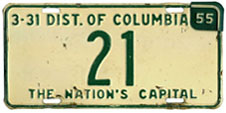 |
1952 (exp. 3-31-53) |
1953 (exp. 3-31-54) |
1954 (exp. 3-31-55)
|
As a result of Mr. Cole's memo, Mr. Keneipp proposed to the Commissioners later in May that beginning with the 1953 registration year the only all-number registrations issued be 1 through 999, to be assigned by the Commissioners. “Requests for special or low numbered tags have now reached the point where a critical situation has been created,” wrote the Director. “For a number of years past it has been the policy of the Board of Commissioners to assign the numbers beginning at 1 and ending at number 999. The Department of Vehicles and Traffic has assigned numbers beginning at 1000 to 9999 and one and two numbered tags with a letter prefix, amounting to a total of approximately 15,000 to 20,000 numbers. Requests now received are not just for low numbers but for street numbers, telephone numbers, and trick numbers. It is estimated that it costs the District more to issue these special numbered tags which constitute about 10% of the total tags issued than it does to issue the remaining 90%.” Despite his lengthy, impassioned plea to drastically reduce the quantity of reserved registration numbers (only a small portion of which has been reproduced here), on May 27, 1952, the Commissioners denied Mr. Keneipp's proposal. The necessity of processing so many special registrations continued for a few more years, until 1955, when the general-issue registration number format was changed, eliminating plates numbered above 1000 and those with single-letter prefixes.
Registration Number Assignment Since 1955:
The Modern System of D.C. Reserved-Number Registrations
Beginning with the 1955 registration year, the only all-number plates in use were those assigned annually by the Board of Commissioners: the reserved passenger series of 1 through 1000. All other auto plates issued for 1955 and 1956 are marked with two letters followed by four numbers, beginning at AA-10-00, so it was during these years that all-number plates, with the quantity issued now reduced significantly, became far more exclusive and distinctive than they had been previously.
Effective with the 1957 ("3-31-58") plate, the quantity of reserved registrations was increased by 200 so that numbers 1-1200 were assigned by the Commissioners. This change is called for in DMV documentation dated March 7, 1957. This is the same time at which the general-issue format was changed to AB-123.
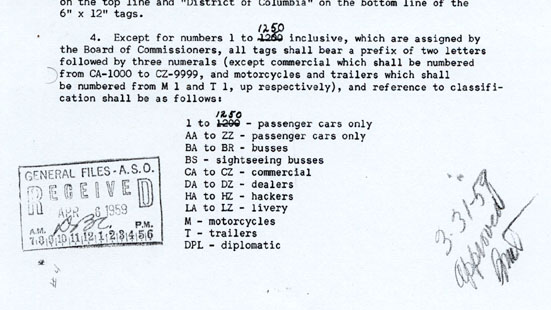
The timing of the increase in the quantity of available reserved-number registrations from 1,200 to 1,250 is slightly less clear, but we believe that it was effective with the 1960 ("3-31-61") plate. Shown above is a portion of a March 2, 1959, memo in which specifications for 1960 plates are provided. As may be seen, the specification that plates "1 to 1200" were to be made and assigned by the Commissioners has been manually altered, calling for 1,250 plates.
It is important to note that we have no evidence to indicate that this change was made before the plates were made and issued, which is to say that there is a possibility that plates up to 1250 were made previously, perhaps during the useful live of the 1959 ("3-31-60") plate, and that changes to the 1960 specifications memo were made in order to reflect plates that were by spring 1959 already in use. However, we believe that the change was in fact made while 1960 plates were being planned. The March 2 memo is the earliest that we have regarding 1960 plates, whereas later a later version (dated March 31, 1959) includes the highest reserved number, 1250, properly typed where above it is noted by hand.
So as to present as complete a picture as possible about this change in order that individuals can draw their own conclusion as to when plates 1201 through 1250 were likely introduced, it is worth noting that 1959 plates are unusual in that their specifications, including the issuance of reserved plates 1 through 1200, were dictated in an early 1957 DMV directive in which characteristics of both 1958 and 1959 plates are provided. For most years of this era a new set of specifications was issued in a separate annual memo, usually generated about ten months before the corresponding plates would be introduced. For 1959, however, all decisions appear to have been made a year earlier than usual, in conjunction with development of the 1958 plates. This may have been done in light of the many changes made to District of Columbia plates for 1957 ("3-31-58"), which is to say that officials may have wanted to "lock in" the 1957 changes for at least a few years (although often provisions of these memos were amended with short notice or "on the fly" as changes in the original plan were required out of necessity). With no 1959-specific plate specification memos it is possible that numbers up to 1250 were made for or during that registration year and that the 1960 memo shown above was altered to reflect something that had already been done, but we do in fact believe that this is not the case and that numbers 1201 through 1250 were first issued for the 1960 registration year.
Ever since the change that we believe took place effective April 1, 1960, there have been 1,250 reserved registrations. How these numbers have been assigned over the years is a subject that will be addressed here in the future.
Click here to read examples of 1951-1967 motorist appeals for reserved and general-issue registration numbers.
Click here to read about how reserved registration numbers were assigned for 1958.
Reserved-Number License Plates Since 1955
D.C. license plates upon which reserved numbers are displayed were identical in construction and appearance to general-issue plates through the 1968 registration year, which ended on March 31, 1969. For the 1969 registration year, each existing reserved plate was revalidated with a black-on-yellow sticker, to be placed in the upper right corner (as were general-issue auto plates), but motorists to whom new reserved registrations were assigned during the year received black-on-white plates with "3-31" and "70" stamped in the upper left and right corners, respectively.
For the next four registration years, 1970 (exp. 3-31-71) through 1973 (exp. 3-31-74), new dated black-on-white plates were issued annually (while general-issue plates were being validated with stickers). New reserved-number plates have been issued annually ever since, making this one of several plate- and registration-related details that makes Washington, D.C. unique. This is the only place in the United States where at least some passenger car owners still receive a new pair of license plates every year, and this now-unusual practice continues because it facilitates reassignment of the coveted numbers annually.
Beginning with the 1974 ("Bicentennial") base reserved-number plates were validated with stickers, making them look like multi-year plates, but none were used for more than a single twelve-month period and none should have ever had more than a single sticker applied to them. When the expiration of general-issue passenger registrations began to be staggered in 1983 reserved-number registrations continued to be issued annually using an April-March registration year, and this remains the practice today. Low-number plates followed the matching sticker serial number rule from 1967 through 1987 as described on the stickers page.
As for their design, reserved-number plates of the 1974 (exp. 3-31-75) to 2000 (exp 3-31-2001) registration years closely resemble the general-issue design. Since 2001 the D.C. government has taken advantage of the annual plate replacement to experiment with some interesting and unusual graphics. There are two distinct varieties of the 2012 issue. The earliest plates to be distributed have SEE WINDOW STICKER erroneously printed in the upper corners; most plates properly feature the expiration date, instead. The 2013 issue reflects the change from WASHINGTON, D.C. back to DISTRICT OF COLUMBIA that was announced only a few weeks prior to March 11, the first day that assignees could call for them. The 2017 plate is intended to be a two-year issue, with EXPIRES MAR 31, 2019 printed in each upper corner.
 |
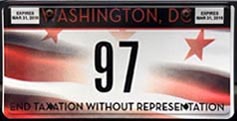 |
2016 (exp. 3-31-2017) |
2017 (exp. 3-31-2019)
|
|
The American Beauty rose, an image of which appears on the 2011 reserved-number plate, is the official flower of the District of Columbia. |
An image of a wood thrush, official bird of the District of Columbia, adorns the 2010 reserved-number plate. Look carefully at the image of plate number 142 above compared to earlier plates and you'll see that the 2010 plates are made with numbers that are slightly shorter than those used from 2002 through 2009. |
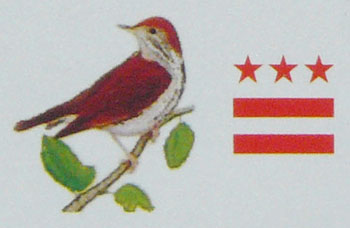 |
|
The 2009 reserved-number plate includes an image of a pink cherry blossom in the center. Plate no. 7 had just been picked up at the DMV on March 30, 2009, when it was shown to DCplates.net photographer J. Reid Williamson. |
Click here to see photographs of reserved plates in use.
|
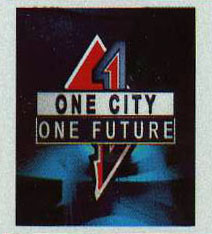 |
Correlation Between Registration and Sticker Serial Numbers
on Reserved-Number Plates
Just as there is a correlation between general-issue registration numbers and the serial number of stickers applied to them (in certain instances, as discussed here), such a relationship also exists on reserved-number plates. There are, however, a few noteworthy differences.
With one or two exceptions in the late 1960s, validation stickers didn't begin to be used on reserved-number plates until the 1975 registration year. Although since 1974 these special plates have been validated in the same manner as general-issue plates, from 1975 (with a sticker marked "76") through 2002 (with an "03" sticker) new plates were always issued annually (in pairs), which is to say that they were never validated with more than a single sticker. Therefore, it would appear that there is no reasonable purpose for a license plate collector to remove a sticker from a low-number plate and place it on another one. In fact, because from 1975 through at least 1990 the sticker and plate numbers are related, undertaking the cumbersome process of removing a plate's sticker in order to affix it to another low-number plate makes no sense at all. Nevertheless, some collectors have indeed engaged in this activity.
Information about the relationship between plate and sticker serial numbers is provided here in order to assist collectors in the determination of the originality (and therefore correctness) of their 1975-1990 reserved-number plates. In all cases, validation stickers are thought to have been applied to the plates shortly after they were manufactured and before they were delivered to the DMV for distribution to motorists. If this did not occur, then the stickers were likely applied by DMV workers before the plates were issued. Information about serial numbers of stickers used on all plate types is provided here.
Although expiration month designation stickers began to be used on reserved-number plates in 1984, no relationship between their serial numbers and registration numbers has be identified. Some month stickers have no serial number. References to stickers in the 1984 and later sections below are to year stickers only.
1975: "76" sticker on the 1974 ("BICENTENNIAL") Baseplate. The first year that stickers were used on the 1974 base, both general-issue and reserved varieties, is also the first year for which a relationship between the plate number and sticker serial is evident. However, this year is unusual in that there is no exact correlation. We have observed eleven reserved-number plates that appear to have their original stickers, with 13 and 323 being the lowest and highest numbers, and in all cases the sticker serial is between 372,630 and 373,784 numbers higher than the plate number. In other words, stickers on these eleven plates have serials in the high 372000 series and the 373000 series, but the difference between plate and sticker numbers is inconsistent, unlike 1976 and most later years. Therefore, it appears that a batch of 1,125 pairs of consecutively-numbered stickers were used to validate 1974 baseplates issued for the 1975 registration year, but that the stickers were not applied to the plates in any relation to the registration numbers.
1976: "77" sticker on the 1974 ("BICENTENNIAL") Baseplate. On all thirteen 1976 reserved-number plates that we observed (with numbers between 5 and 236), the sticker serial is 455,000 numbers higher than the plate number, which is to say that the block of stickers set aside for application to 1976 reserved-number plates appears to have begun with sticker no. 455001. Therefore, for example, the "77" sticker applied to plate number 5 is number 455005, and that appearing on plate 236 is no. 455236.
1977: "78" sticker on the 1974 ("BICENTENNIAL") Baseplate. On all twelve 1977 reserved-number plates that we observed (with numbers between 9 and 237), the sticker serial is 750,000 numbers higher than the plate number, which is to say that the block of stickers set aside for application to 1977 reserved-number plates appears to have begun with sticker no. 750001. Therefore, for example, the "78" sticker applied to plate number 9 is number 750009, and that appearing on plate 237 is no. 750237.
1978: "79" sticker on the 1978 ("NATION'S CAPITAL ") Baseplate. On all eight 1978 reserved-number plates that we observed (with numbers between 12 and 1237), the sticker serial is 435,100 numbers higher than the plate number, which is to say that the block of stickers set aside for application to 1978 reserved-number plates appears to have begun with sticker no. 435101. Therefore, for example, the "79" sticker applied to plate number 12 is number 435112, and that appearing on plate 1237 is no. 436337.
1979: "3-31-80" sticker on the 1978 ("NATION'S CAPITAL ") Baseplate. On all five 1979 reserved-number plates that we observed (with numbers between 5 and 1117), the sticker serial is 167,000 numbers higher than the plate number, which is to say that the block of stickers set aside for application to 1979 reserved-number plates appears to have begun with sticker no. 167001. Therefore, for example, the "79" sticker applied to plate number 5 is number 167005, and that appearing on plate 1117 is no. 168117.
1980: "3-31-81" sticker on the 1978 ("NATION'S CAPITAL ") Baseplate. On all six 1980 reserved-number plates that we observed (with numbers between 3 and 1061), the sticker serial is 664,500 numbers higher than the plate number, which is to say that the block of stickers set aside for application to 1980 reserved-number plates appears to have begun with sticker no. 664501. Therefore, for example, the "3-31-80" sticker applied to plate number 3 is number 664503, and that appearing on plate 1061 is no. 665561.
1981: "3-31-82" sticker on the 1978 ("NATION'S CAPITAL ") Baseplate. On all five 1981 reserved-number plates that we observed (with numbers between 8 and 1061), the sticker serial is 171,500 numbers higher than the plate number, which is to say that the block of stickers set aside for application to 1981 reserved-number plates appears to have begun with sticker no. 171501. Therefore, for example, the "3-31-82" sticker applied to plate number 8 is number 171508, and that appearing on plate 1061 is no. 172561.
1982: "3-31-83" sticker on the 1978 ("NATION'S CAPITAL ") Baseplate. On all four 1982 reserved-number plates that we observed (with numbers between 3 and 1061), the sticker serial is 155,250 numbers higher than the plate number, which is to say that the block of stickers set aside for application to 1982 reserved-number plates appears to have begun with sticker no. 155251. Therefore, for example, the "3-31-83" sticker applied to plate number 3 is number 155253, and that appearing on plate 1061 is no. 156311.
1983: "3-31-84" sticker on the 1978 ("NATION'S CAPITAL ") Baseplate. On both 1983 reserved-number plates that we observed (with numbers 99 and 1061), the sticker serial is 147,250 numbers higher than the plate number, which is to say that the block of stickers set aside for application to 1983 reserved-number plates appears to have begun with sticker no. 147251. The "3-31-83" sticker applied to plate number 99 is number 147349, and that appearing on plate 1061 is no. 148311.
1984: "85" sticker on the 1978 ("NATION'S CAPITAL ") Baseplate. On all three 1984 reserved-number plates that we observed (with numbers between 13 and 1061), the sticker serial is 65,551 numbers higher than the plate number, which is to say that the block of stickers set aside for application to 1984 reserved-number plates appears to have begun with sticker no. 65,552. Therefore, for example, the "85" sticker applied to plate number 13 is number 65564, and that appearing on plate 1061 is no. 66612.
1985: "86" sticker on the 1984 ("A Capital City") Baseplate. The first year that annual reserved-number plates were made on the Capital City background is unusual in that, like 1975, there does not appear to be an exact correlation between plate and sticker numbers. We have observed three reserved-number 1985 plates that appear to have their original stickers, with 24 and 1061 being the lowest and highest numbers, and in all cases the sticker serial is between 166,382 and 167,679 numbers higher than the plate number. In other words, although stickers on these three plates have serials in the 167000 series, the difference between plate and sticker numbers is inconsistent. Therefore, it appears that a batch of 1,125 pairs of consecutively-numbered stickers were used to validate reserved plates issued for the 1985 registration year, but the stickers do not appear to have been applied to plates in any relation to their registration numbers.
1986: "87" sticker on the 1984 ("A Capital City") Baseplate. On all three 1986 reserved-number plates that we observed (with numbers between 13 and 1061), the sticker serial is 490,000 numbers higher than the plate number, which is to say that the block of stickers set aside for application to 1986 reserved-number plates appears to have begun with sticker no. 490,001. Therefore, for example, the "86" sticker applied to plate number 13 is number 490013, and that appearing on plate 1061 is no. 491061.
1987: "88" sticker on the 1984 ("A Capital City") Baseplate. We have observed only a single reserved-number 1987 plate, number 161. Its sticker serial number is 723161, suggesting that the block of stickers set aside for application to 1987 reserved-number plates may have begun with sticker no. 723001.
1988: "89" sticker on the 1984 ("A Capital City") Baseplate. On both 1988 reserved-number plates that we observed (with numbers 161 and 1061), the sticker serial is 25,000 numbers higher than the plate number, which is to say that the block of stickers set aside for application to 1988 reserved-number plates appears to have begun with sticker no. 25001. The "89" sticker applied to plate number 161 is number 25161, and that appearing on plate 1061 is no. 26061.
By late 1987 or early 1988, when these plates were likely manufactured and prepared for issuance (by having the stickers applied), the practice of having the final three digits of the sticker serial number match the registration number on the general-issue plate to which it was applied had been abandoned. Therefore, it is somewhat surprising that the practice was continued on reserved-number plates, and it is not surprising to see evidence of the practice having been abandoned a few years later.
1989: "90" sticker on the 1984 ("A Capital City") Baseplate. We have observed only two reserved-number plates of this year that appear to have an original year sticker, and the interval between their plate and sticker serial numbers is inconsistent. Although the sticker serial on plate no. 75 is 35075 (so the interval is a reasonable 35,000), the serial on plate 1061 is 353682.
1990: "91" sticker on the 1984 ("A Capital City") Baseplate. The last year that the Capital City background was used in the manufacture of reserved-number plates is also the last year for which we have seen any relationship between plate and sticker serial numbers. Plate no. 81 has sticker number 000081, and the sticker on plate 1091 is number 001091, suggesting that sticker serials should exactly match plate numbers. However, sticker no. 003530 is attached to plate no. 24, which is inconsistent with the two other examples cited. If indeed the sticker and plate numbers should match for this year, perhaps the sticker on plate no. 24 is not original (i.e. it may have been changed by a license plate collector), or maybe the sticker originally intended to be affixed to this plate (no. 000024) was spoiled before it could be applied, necessitating the use of a randomly-numbered substitute.
Although the validation of reserved-number plates continued to be indicated with stickers until 2002, we have seen only one or two examples of each year since 1991 that appear to have original stickers. None of these plates exhibit evidence to suggest that there was any relationship between plate and sticker serial numbers after 1990.
|
This page last updated on December 31, 2017 |
 |
|
copyright 2006-2018 Eastern Seaboard Press Information and images on this Web site may not be copied or reproduced in any manner without consent of the owner. For information, send an e-mail to admin@DCplates.net |















